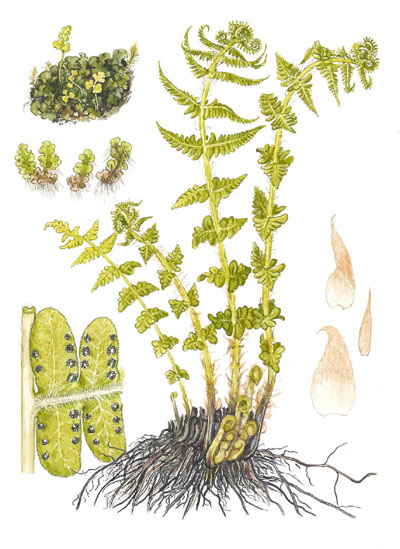|
Hardy Fern Home O. limbosperma resources All Ferns � Thelypteridaceae �� Oreopteris
�Other Genera
|
| Oreopteris limbosperma | ||
Sweet mountain fern, Lemon-scented fern | ||
|
Etymology
Limbo = marginal, spermum = seed; marginal seed/sori; the first name was Polypodium limbospermum assigned in 1789 when sori were not regarded so distinctly from seeds.
Description
Rhizome: erect, branching, triangular scales.
Frond: 120 cm high by 20 cm wide, deciduous, monomorphic or somewhat dimorphic, blade/stipe ratio: 5:1. Stipe: grooved above (not continuous) or not, scales thin, silvery early, later pale buff, continuing onto the rachis, vascular bundles: 2, crescent-shaped. Blade: 1-pinnate-pinnatifid, ovate, tapering at the base to widely-spaced, very short pinnae, soft, yellow-green early, pale green later, transparent needlelike hairs on the costae, yellow glands on the lower surface. Pinnae: 30 to 40 pair, pinnatifid above, lowest ones losing this character; costae grooved above, grooves discontinuous from rachis to costae; margins entire to shallowly crenate, fertile segments inrolled; veins free. Sori: round, touching at maturity, more plentiful on the upper portion of the frond, near the margins, indusium: absent (to the eye), sporangia: pale green early, later black, glossy, maturity: mid to late summer. Culture
Habitat: moist, acidic, shady woods, banks.
Distribution: widely scattered in Europe, from the Azores to Norway to Turkey.
Hardy to -25�C, USDA Zone 5.
Distinctive Characteristics
lemon scent when the glands on the lower surface are brushed; inrolled fertile margins
Synonyms
Polypodium limbospermum All. Dryopteris montana O. Kuntze Thelypteris limbosperma (Allioni) H.P. Fuchs Thelypteris oreopteris (Ehrh.) Slosson Dryopteris oreopteris (Ehrh.) Maxon Aspidium montanum Aschers. Lastrea oreopteris Bory |
|
|
Notes
Taxonomy Thelypteris quelpaertensis (or Oreopteris quelpaertensis), of northeastern Asia, northwestern North America and disjunct in Newfoundland,�is very similar and was earlier called (by either genus) limbosperma. It is omitted here as�believed not to be in cultivation.
Taxonomy Thelypteris quelpaertensis (or Oreopteris quelpaertensis), of northeastern Asia, northwestern North America and disjunct in Newfoundland,�is very similar and was earlier called (by either genus) limbosperma. It is omitted here as�believed not to be in cultivation.
|
Oreopteris limbosperma. Habit, growing with Vaccinium uliginosum, Cornus suecica, and Deschamsia flexuosa. �Illustration from Scandinavian Ferns by Benjamin �llgaard and Kirsten Tind, Rhodos, 1993. |
